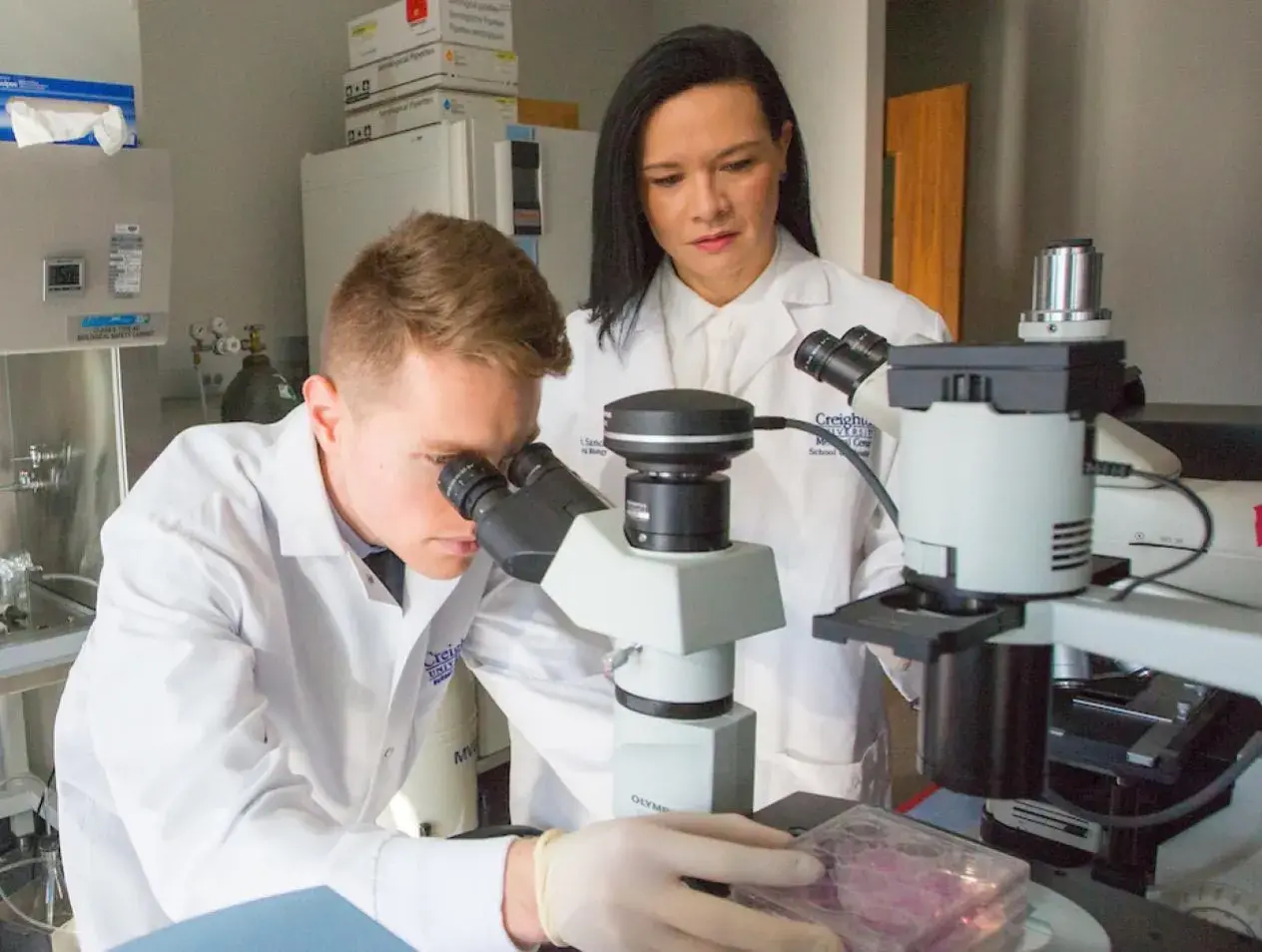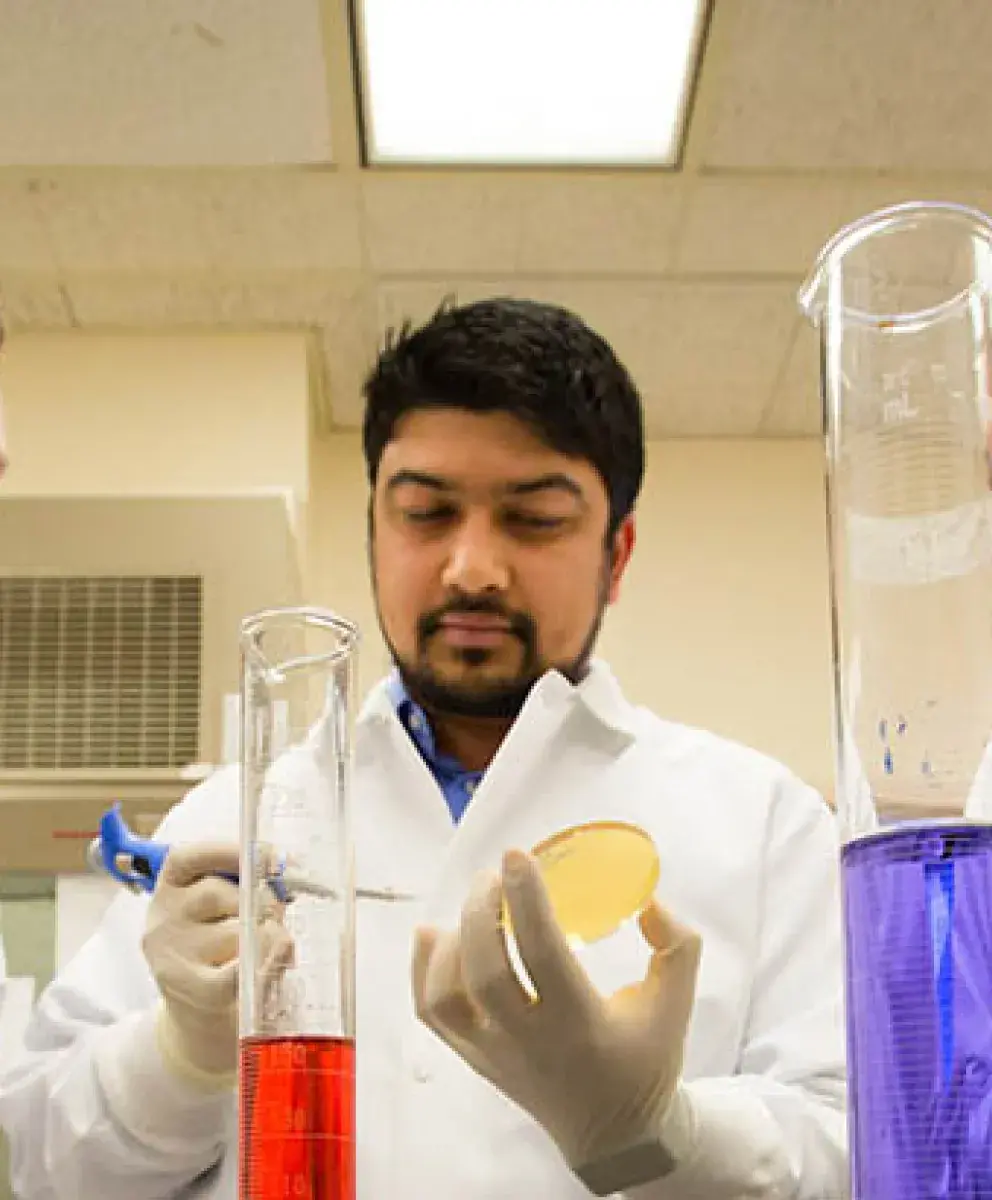
Dentistry Research at Creighton
Cutting-edge science in the spirit of service.
Scholarly activity is an integral component of the mission of the School of Dentistry and Creighton University, and we design all our research initiatives with the goal of better patient care. Extramural research funding totals nearly $1.5 million from federal agencies, foundations, corporations and other donors.
By conducting research focused on enhancing teaching, bettering society, and discovering new knowledge, the School of Dentistry has built a national and international reputation for science that serves.
Student Research Opportunities
Under the mentorship of our faculty, we strive to enhance student learning opportunities through the discovery of new knowledge.
- Students complete a research training course, ‘Conduct of Research’, during their first semester of dental school. Completion of this course allows them to experience scientific inquiry in all its phases.
- All our first-year students participate in group research projects, which they present to the school’s faculty and alumni.
- Our students can collaborate with both basic science and clinical faculty members in conducting research. Students directly contribute to the production of peer-reviewed scientific publications as well as public presentation of research findings. In the past, our students have addressed audiences as distinguished as the American Association for Dental Research and the International Association for Dental Research.
- Pursuing such opportunities enhances the applications of our students to postdoctoral programs in dental specialties.
International Partnerships
The Creighton University School of Dentistry has international research partnerships with the Department of Operative Dentistry in Nihon University in Tokyo, Japan, and Shofu Corporation in Kyoto, Japan. These academic and industrial fellowships have resulted in several research abstracts being presented at national and international research meeting and publications in peer-reviewed journals.
Recognized for Research
The School of Dentistry is well recognized in the research community for its excellence in dental materials research. Supported by grants and partnerships, the research enterprise includes clinical trials on material and technique as well as laboratory investigations and collaborations with several Creighton University departments and institutions in Japan. Junior faculty, postdoctoral fellows, and graduate and undergraduate students take an active role in current research in dentistry, such as:
- adhesive dentistry and wear characteristics of resin composites and resin cements
- biology of lysophosphatidic acid in periodontal disease
- development of new dental products that combat recurrent decay
- auditory and oral tissue regeneration, caries research and oral inflammation
- translational research
- development of an inducible Dominant-Negative Retinoblastoma 1 (Rb1) mouse model
- role of miRNAs and their therapeutic potential in regenerating mammalian hair cells in treating hearing loss disease
- periostin’s role in dental tissue homeostasis
Featured Research
Many of our faculty have secured extramural funding from public and private sources to include the National Institutes of Health, the dental industry and foundations.
Faculty-driven research at the School of Dentistry ranges from basic sciences to clinical investigations, including a variety of materials and techniques with translational potential into clinical applications to provide better care to our patients.

Highlighted Research Areas
Wayne W. Barkmeier, DDS, MS
Special Professor and Dean Emeritus
Dr. Barkmeier is extensively involved in biomaterials research and has conducted numerous clinical and laboratory evaluations on dental restorative materials. He has authored over 200 articles in professional journals and has lectured throughout the world on dental materials and restorative procedures. The focus of his research interest is in the areas of adhesive dentistry and wear characteristics of resin composites and resin cements. Current investigations involve shear bond strength and shear fatigue strength testing of current generation adhesive systems. These investigations also evaluate the surface morphological changes of mineralized tooth structures treated with the various adhesive bonding agents using scanning electron microscopy and non-contact profilometry. Wear studies have included simulated localized and generalized wear.
Current collaborations are with the Department of Physics at Creighton University in the area of atomic force microscopy and Nihon University School of Dentistry in Tokyo, Japan in the areas of adhesion and wear.
Roselyn Cerutis, PhD
Associate Professor of Oral Biology
Dr. Cerutis’ laboratory works collaboratively with dentists in the Department of Periodontics and the Department of Oral and Maxillofacial Surgery. The team’s long-term goal is to understand the biology of lysophosphatidic acid (LPA) in periodontal disease. LPA is a pleiotropic small lipid that plays key roles in homeostasis and inflammation, and in many conditions where inflammation is the underlying process—such as atherosclerosis, cancer and rheumatoid arthritis. However, its role in periodontal disease is only now being determined. Over the years, many junior and senior dental students have contributed to the productivity of our laboratory research.
Stephen M. Gross, PhD
Associate Professor, Department of Chemistry
Dr. Gross in collaboration with Dr. Latta have focused their research interests on the development of new dental materials that improve oral healthcare.
Caries initiation at the interface of dental materials and mineralized tooth structure continues to be a significant issue. Their research group mainly focuses on encapsulating bioactive therapeutic agents that can be incorporated into dental products that combat recurrent decay. Encapsulation of aqueous solutions of salts containing fluoride, calcium and phosphate ions provide a method for delivering remineralizing ions in their bioactive form. These microcapsules, when formulated into a dental material, allows for ion release by passive diffusion for an extended period of time in the proximity of the material-enamel interface.
Studies focus on ion release rates, enamel fluoride uptake and the effect of microcapsule inclusion on material properties.
Sonia Rocha-Sanchez, PhD
Associate Professor of Human Physiology and Biomedical Sciences of Oral Biology
Assistant Dean of Research
Dr. Rocha-Sanchez leads an active research program mentoring junior faculty, postdoctoral fellows, graduate and undergraduate students in a variety of research projects. Current projects include auditory and oral tissue regeneration, caries research and oral inflammation.
Her lab’s past and current research has been funded by several federally and privately funded grants. Her current research projects involves the development of an inducible Dominant-Negative Retinoblastoma 1 (Rb1) mouse model, which offers potential research application on a broad variety of research areas.
Dr. Rocha-Sanchez is active in translational research as well, discovering ways to develop innovative products derived from her findings. In fact, she founded and serves as vice president of F&S Medical Solutions LLC, a company focused on research and development of medical devices and therapeutic interventions.
Michael D. Weston, MA, PhD
Assistant Professor of Oral Biology
Dr. Weston currently has research support from the Nebraska Tobacco Settlement Biomedical Research Development New Initiative Grant (LB692). The spontaneity of cochlear sensory hair cell (HC) regeneration has been lost in mammalian species which is why human hearing loss is irreversible following HC death. The project focuses on learning the role of miRNAs and their therapeutic potential in regenerating mammalian hair cells in the cochlea using mouse models to reprogram cell fates in the inner ear. The current objective to generate direct evidence that miRNA directed gene regulation promotes postnatal conversion of non-sensory cells into sensory cells.
The study should provide the hearing research field with a better understanding of the biological relevance of miRNAs in regenerating mammalian hair cells. Moreover, it will add novel and medically relevant mechanistic insights in the control of gene expression by miRNAs, which may lead to novel ways of thinking about how, when, and where to employ potential therapeutic RNAs to test their efficacy in treating hearing loss disease.
Dr. Weston is also supported from the CURAS Faculty Research Fund. Worldwide, 80% of adults have some degree of periodontal disease and 13% have chronic severe disease that includes permanent tooth loss. The project focuses on studying periostin’s role in dental tissue homeostasis. Periostin, abundant in the periodontal ligament (PDL) of humans and mice, is an extracellular protein that communicates dynamic changes in mechanical loading to influence cell-matrix interactions and cell function. The award will provide funds to engage Creighton undergraduate students in tissue culture experiments to study cell signaling using fibroblasts isolated from the oral cavity of mice to better understand periodontal disease development and progression.




